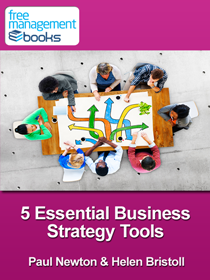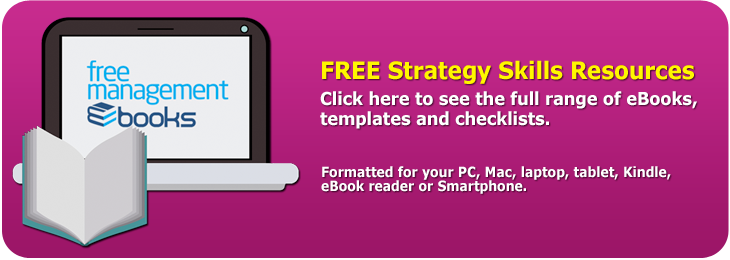Five Essential Business Strategy Tools - Free eBook in PDF Format
 |
 |
|
Book Description - ISBN 978-1-62620-977-6 (38 Pages)
This free eBook describes five essential business strategy tools that are used by organizations to align their activities, resources, relationships and processes to ensure their future strategy is profitable. These tools will help your decision-making and involvement in the business strategy process.
Chapter 1 - MOST Analysis
The MOST Analysis used to keep the alignment of day-to-day activities and the organization’s long-term vision on track. By reviewing each of its components – Mission, Objectives, Strategy and Tactics – from the top down gaining more detail as it progresses activities can be allocated so that they support the long-term goals. The MOST Analysis tool allows management a better understanding of how to ensure daily activities drive the organization towards its desired goal.
Chapter 2 - Resource Audit
Every organization wants to maximize their opportunities and conducting a resources audit allows management to make effective choices when allocating its resources. It will be unique to your organization and requires up-to-date figures on all the resources at its disposal. As an aid to decision making it is invaluable and well worth investing the time needed to perform a resource audit.
Chapter 3 - McKinsey 7-S Model
The McKinsey 7-S Model is tool designed specifically to aid organizations in how they align its different aspects and identify areas of potential improvement. As the model name suggests it consists of seven areas. These are split into what it refers to hard elements - strategy, structure and systems – and soft elements - shared values, skills, style, and staff. The purpose of this investigation is to assess how well each of these seven elements works with the others. When they all work in harmony performance is able to meet stakeholder expectations.
Chapter 4 - Four View Model
This model uses different viewpoints to give management insight into how well an organization is performing both now and in the future. By considering business operations from several views management open up their minds to other possibilities and opportunities. The four views of this model are the Logical, Process, Development and Physical View.
Chapter 5 - Balanced Business Scorecard
This method of making sure activities are aligned to organizational goals is one of the most popular tools. The Balanced Business Scorecard enables you to gain a top-level view of everything that occurs within the organization. Its findings allow management to make decisions that improve operations and performance. It has four sections - Financial, Customer, Internal Processes, and Learning and Growth. Each must be allocated sufficient time and attention to ensure it is fully understood and utilized.
| You will learn: |
|
![]()
![]()
What is a MOST Analysis?
- MOST Analysis is a simple framework tool for analysing or planning the detail of what an organisation does.
- It helps you frame questions, starting from the high-level mission of the organisation and digging right down to the detail of individual tactics.
- MOST stands for: Mission, Objectives, Strategy and Tactics.
- The mission of an organisation should be the answer to the question ‘What do you do?’
- Objectives start with the translation of the mission into overall intent that drives the strategy process.
- Strategy includes the high-level decisions that shape what is done and how.
- Tactical planning takes strategic decisions and figures out how to implement them in practice.
What is a Resource Audit?
- The resource audit identifies the resources available to a business.
- Some of these may be owned (e.g. plant and machinery, trademarks, retail outlets) whereas others can be obtained through partnerships, joint ventures or suppliers.
- Financial resources include the organisation’s financial assets including the ability to raise finance via credit.
- Physical resources include buildings and equipment, which may be either owned or leased.
- Human resources include both permanent and temporary staff.
- Reputation is a reflection of how the organization is perceived in the marketplace.
- Know-how is the intellectual property that enables the organization to function.
What is the McKinsey 7-S Framework?
- The McKinsey 7-S Framework is a tool designed to help business owners and managers understand how aligned their organization is, and where it can be approved.
- The framework is most often used as an organizational analysis tool to assess and monitor changes in the internal situation of an organization.
- It is based on the theory that, for an organization to perform well, seven elements need to be aligned and mutually reinforcing. They are:
- Strategy – Purpose of the business and the way the organization seeks to enhance its competitive advantage.
- Structure – Division of activities; integration and coordination mechanisms.
- Systems – Formal procedures for measurement, reward and resource allocation.
- Shared Values – The overall culture of the company, and the purpose behind everything that is done.
- Skills – The organization’s core competencies and distinctive capabilities.
- Staff – Organization’s human resources, demographic, educational and attitudinal characteristics.
- Style – Typical behaviour patterns of key groups, such as managers, and other professionals.
- The framework can be used to help identify what needs to be realigned to improve performance, or to maintain performance during other types of change.
What is the Four-View Model?
- The four-view model has its origins in software engineering but it can also be used outside of that discipline.
- The logical view is where the overall structure of the application is conveyed. Another way to characterize the logical view is to think of it as the interfaces to the environment in the most general of contexts.
- The process view is used to paint a picture describing the underlying processes and tasks which are occurring within the system, as well as the channels of communication between them. The interrelationships amongst processes should be visible as well as the synchronization mechanisms.
- The development view provides perspective on the software’s organization. The components of the system as well as their inter-dependencies are outlined within this view.
- The physical view is used to describe the hardware and software setup that is required by the system. In this view we gain an appreciation of how the hardware and software components are combined to form the deployed product.
What is the Balanced Business Scorecard?
- The Balanced Scorecard (BSC) is a semi-standard structured report that can be used by managers to keep track of the execution of activities by the staff within their control and to monitor the consequences arising from these actions.
- It focuses on the strategic agenda of the organization, the selection of a small number of data items to monitor and a mix of financial and non-financial data items.
- Using the Balanced Business Scorecard is a decision that countless organizations have used over the years to review how they are functioning, and where they could improve.


